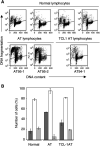Telomerase activity, apoptosis and cell cycle progression in ataxia telangiectasia lymphocytes expressing TCL1
- PMID: 12966431
- PMCID: PMC2376941
- DOI: 10.1038/sj.bjc.6601213
Telomerase activity, apoptosis and cell cycle progression in ataxia telangiectasia lymphocytes expressing TCL1
Abstract
Individuals affected by ataxia telangiectasia (AT) have a marked susceptibility to cancer. Ataxia telangiectasia cells, in addition to defects in cell cycle checkpoints, show dysfunction of apoptosis and of telomeres, which are both thought to have a role in the progression of malignancy. In 1-5% of patients with AT, clonal expansion of T lymphocytes carrying t(14;14) chromosomal translocation, deregulating TCL1 gene(s), has been described. While it is known that these cells can progress with time to a frank leukaemia, the molecular pathway leading to tumorigenesis has not yet been fully investigated. In this study, we compared AT clonal cells, representing 88% of the entire T lymphocytes (AT94-1) and expressing TCL1 oncogene (ATM(-) TCL1(+)), cell cycle progression to T lymphocytes of AT patients without TCL1 expression (ATM(-) TCL1(-)) by analysing their spontaneous apoptosis rate, spontaneous telomerase activity and telomere instability. We show that in ATM(-) TCL1(+) lymphocytes, apoptosis rate and cell cycle progression are restored back to a rate comparable with that observed in normal lymphocytes while telomere dysfunction is maintained.
Figures


Similar articles
-
TCL1 oncogene activation in preleukemic T cells from a case of ataxia-telangiectasia.Blood. 1995 Sep 15;86(6):2358-64. Blood. 1995. PMID: 7662982
-
Telomeric associations and chromosome instability in ataxia telangiectasia T cells characterized by TCL1 expression.Cancer Genet Cytogenet. 2001 Feb;125(1):46-51. doi: 10.1016/s0165-4608(00)00358-7. Cancer Genet Cytogenet. 2001. PMID: 11297767
-
Expression of either the TCL1 oncogene, or transcripts from its homologue MTCP1/c6.1B, in leukaemic and non-leukaemic T cells from ataxia telangiectasia patients.Oncogene. 1996 Jan 18;12(2):379-86. Oncogene. 1996. PMID: 8570215
-
ATM function and telomere stability.Oncogene. 2002 Jan 21;21(4):611-8. doi: 10.1038/sj.onc.1205060. Oncogene. 2002. PMID: 11850786 Review.
-
[ATM and telomere instability].Yi Chuan Xue Bao. 2004 Feb;31(2):212-6. Yi Chuan Xue Bao. 2004. PMID: 15473314 Review. Chinese.
Cited by
-
Tcl1 interacts with Atm and enhances NF-κB activation in hematologic malignancies.Blood. 2012 Jan 5;119(1):180-7. doi: 10.1182/blood-2011-08-374561. Epub 2011 Nov 7. Blood. 2012. PMID: 22065599 Free PMC article.
-
Actionable perturbations of damage responses by TCL1/ATM and epigenetic lesions form the basis of T-PLL.Nat Commun. 2018 Feb 15;9(1):697. doi: 10.1038/s41467-017-02688-6. Nat Commun. 2018. PMID: 29449575 Free PMC article.
References
-
- Bebb DG, Warrington PJ, de Jong G, Yu Z, Moffat JA, Skov K, Spacey S, Gelmon K, Glickman BW (2001) Radiation induced apoptosis in ataxia telangiectasia homozygote, heterozygote and normal cells. Mutat Res 476: 13–20 - PubMed
-
- Biroccio A, Amodei S, Benassi B, Scarsella M, Cianciulli A, Mottolese M, Del Bufalo D, Leonetti C, Zupi G (2002) Reconstitution of hTERT restores tumorigenicity in melanoma-derived c-Myc low-expressing clones. Oncogene 21: 3011–3019 - PubMed
-
- Blasco MA (2002) Telomerase beyond telomeres. Nat Rev Cancer 2: 627–633 - PubMed
-
- Brennan P, Babbage JW, Burgering BM, Groner B, Reif K, Cantrell DA (1997) Phosphatidylinositol 3-kinase couples the interleukin-2 receptor to the cell cycle regulator E2F. Immunity 7: 679–689 - PubMed
Publication types
MeSH terms
Substances
Grants and funding
LinkOut - more resources
Full Text Sources
Medical
Research Materials
Miscellaneous

